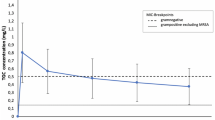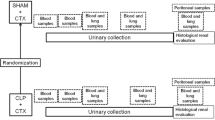Summary
The pharmacokinetics of cefotaxime including formation of its active metabolite desacetyl-cefotaxime were assessed after liver transplantation in three groups of patients (four patients per group):
-
during the postoperative recovery phase (group 1),
-
during an episode of allograft nonfunction (group 2),
-
during an episode of allograft rejection (group 3).
All patients received a single dose of 1 g cefotaxime intravenously. Concentrations of cefotaxime and its metabolite were determined in plasma and urine until 6 to 72 h after medication. The terminal half-life of cefotaxime increased and total clearance decreased due to an impairment of drug metabolism, mainly in patients with a nonfunctioning allograft and during rejection. Thus, no desacetyl-cefotaxime was detectable in urine of any patient and none in plasma of 2/4 patients with a nonfunctioning allograft. In addition, a moderate impairment of renal function in several patients contributed to the delayed elimination of cefotaxime and its metabolite. It can be concluded that liver function after transplantation is correlated with the ability to eliminate cefotaxime. Therefore, administration of half the normal dose is recommended particularly in patients with a nonfunctioning allograft or during rejection.
Zusammenfassung
Die Pharmakokinetik von Cefotaxim sowie die Bildung des aktiven Metaboliten Desacetyl-Cefotaxim wurden in 12 Patienten nach Lebertransplantation untersucht:
-
während der postoperativen Erholungsphase (Gruppe 1),
-
während eines vollständigen Funktionsausfalls des Transplantats (Gruppe 2),
-
während einer Abstoßungsreaktion (Gruppe 3).
Alle Patienten erhielten intravenös einmalig 1 g Cefotaxim; danach wurden die Konzentrationen des Cefotaxim und seines Metaboliten in Plasma und Urin für die Zeitdauer von 6–72 Stunden bestimmt. Aufgrund der verminderten metabolischen Kapazität der Leber war die Halbwertszeit von Cefotaxim verlängert, während die Clearance vermindert war; diese Effekte traten besonders ausgeprägt in den Gruppen 2 und 3 auf. Entsprechend war der Metabolit im Urin bei keinem der Patienten und im Plasma nur bei 2/4 Patienten mit komplettem Funktionsausfall des Transplantats nachweisbar. Zusätzlich war die Elimination des Cefotaxim und seines Metaboliten durch die bei den meisten Patienten gleichzeitig bestehende Einschränkung der Nierenfunktion beeinträchtigt. Aus dieser Studie kann geschlossen werden, daß die Elimination von Cefotaxim bei Patienten nach Lebertransplantation entsprechend dem Grad der Einschränkung der Leberfunktion vermindert ist. Aus diesem Grund wird empfohlen, die Dosis vor allem bei Patienten mit Funktionsausfall des Transplantats oder während einer Abstoßungsreaktion zu halbieren.
Similar content being viewed by others
References
Balant, L., Dayer, P., Auckenthaler, R. Clinical pharmacokinetics of the third generation cephalosporins. Clin. Pharmacokinet. 10 (1985) 101–143.
Ings, R. M. J., Fillastre, J.-P., Godin, M., Leroy, A., Humbert, G. The pharmacokinetics of cefotaxime and its metabolites in subjects with normal and impaired renal function. Rev. Infect. Dis. 4 (Suppl.) (1982) 5379–5391.
Bergan, T., Larsen, E. W., Brodwall, E. K. Pharmacokinetics of a new cephalosporin, cefotaxime (HR 756) in patients with different renal functions. Chemotherapy 28 (1982) 85–104.
Ohkawa, M., Okasho, A., Motoi, J., Tokunaga, S., Shoda, R., Kawaguchi, S., Sawaki, M., Shimamura, M., Hirano, S., Kuroda, K., Awazu, S. Elimination kinetics of cefotaxime and desacetyl cefotaxime in patients with renal insufficiency and during hemodialysis. Chemotherapy 29 (1983) 4–12.
Kampf, D., Borner, K., Möller, M., Kessel, M. Kinetic interactions between azlocillin, cefotaxime and cefotaxime metabolites in normal and impaired renal function. Clin. Pharmacol. Ther. 35 (1984) 214–220.
Matzke, G. R., Abraham, P. A., Halstenson, C. E., Keane, W. F. Cefotaxime and desacetyl cefotaxime kinetics in renal impairment. Clin. Pharmacol. Ther. 38 (1985) 31–36.
Wise, R., Wright, N., Willis, P. J. Pharmacology of cefotaxime and its desacetyl metabolites in renal and hepatic disease. Antimicrob. Agents Chemother. 19 (1981) 526–531.
Höffken, G., Lode, H., Koeppe, P., Ruhnke, M., Borner, K. Pharmacokinetics of cefotaxime and desacetyl- cefotaxime in cirrhosis of the liver. Chemotherapy 30 (1984) 7–17.
Dell, D., Chamberlain, J., Coppin, F. Determination of cefotaxime and desacetyl-cefotaxime in plasma and urine by high-performance liquid chromatography. J. Chromatogr. 226 (1981) 431–440.
Metzler, C. M., Elfring, G. L., McEwen, A. J. A package of computer programs for pharmacokinetic modeling. Biometrics 30 (1974) 562.
Cockroft, D. W., Gault, M. H. Prediction of creatinine clearance from serum creatinine. Nephron 16 (1976) 31–41.
Author information
Authors and Affiliations
Rights and permissions
About this article
Cite this article
Kuse, E., Vogt, P. & Rosenkranz, B. Pharmacokinetics of cefotaxime in patients after liver transplantation. Infection 18, 268–272 (1990). https://doi.org/10.1007/BF01647000
Received:
Accepted:
Issue Date:
DOI: https://doi.org/10.1007/BF01647000




